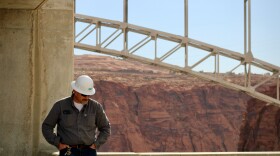Water levels in Lake Powell dropped to a new record low on Tuesday. The nation’s second-largest reservoir is under pressure from climate change and steady demand, and is now the lowest it’s been since it was first filled in the 1960s.
Water levels fell to 3,522.16 feet above sea level, just below the previous record set in April 2022. The reservoir is currently about 22% full, and is expected to keep declining until around May, when mountain snowmelt will rush into the streams that flow downstream to Powell.
Powell, which straddles the border of Utah and Arizona, is fed by the Colorado River. Warming temperatures and abnormally dry conditions have cut into the river’s supplies, and the seven states that use its water have struggled to reduce demand. That imbalance has dealt an alarming blow to the reliability of water supplies for 40 million people, and is threatening the ability to generate hydropower at Glen Canyon Dam, which holds back Lake Powell.
Even though strong snow and heavy rains have blanketed the West this winter, climate scientists say the severity of a 23-year megadrought means that one wet year won’t be nearly enough to substantially boost Lake Powell.
Those dropping water levels have spawned a crisis for the Bureau of Reclamation, the federal agency which manages the West’s largest dams, including Glen Canyon Dam and the hydroelectric turbines within. At 3,490 feet, a level referred to as “minimum power pool,” the bureau may be unable to generate hydropower for 5 million people across seven states. At 3,370 feet, the reservoir hits "dead pool," at which point water can no longer pass through the dam by the power of gravity.
At minimum power pool, water would drop below the intakes that pull water into hydroelectric turbines, allowing air pockets to enter the equipment. That could create tiny bursts of air, part of a process called “cavitation,” and damage the turbines.

In response, the federal government has scrambled to prop up the reservoir, resulting in a patchwork of water conservation agreements insufficient to prevent the reservoir from declining. In 2021 the federal government began emergency water releases from other reservoirs upstream of Powell in an effort to protect Glen Canyon Dam infrastructure. Those releases continued in 2022. This winter, Reclamation has been cutting back on the amount of water released from Lake Powell as part of an existing drought response agreement. Those cuts will boost water levels by about ten feet between December and April.
Eric Balken, executive director of the environmental advocacy group Glen Canyon Institute, said Powell would likely be “well below” minimum power pool by now if not for the emergency releases.
“I think decision makers are trying so hard to prop up Lake Powell because they're really afraid of the infrastructure problems at the dam when it operates below power pool,” Balken said. “That's what it comes down to. And I don't think it's necessarily all about hydropower. I think the dam's ability to actually release water at low levels is problematic enough that they want to avoid it at all costs.”
Balken and other activists have raised alarm about water levels reaching 3,430 feet. At that point, water would fall below normal intakes, and could only flow through the dam via rarely-used backup pipes near its bottom. The Colorado River’s Upper Basin states have a legal obligation to send a certain amount of water downstream each year.
Those backup tubes, known as the “river outlet works,” were originally meant to be a failsafe as well as a mechanism to to pass water in high flow years, and aren’t wide enough to carry the legally required amount of water from one side to the other.
With those threats on the horizon, the federal government began a process to reduce the amount of water released from Lake Powell in 2023 and 2024. As it considers a supplemental environmental impact statement to codify those reductions, Reclamation asked states that use the river’s water to provide suggestions on how to spread out the pain of cutbacks.

In a rare, albeit limited, show of unity, six states signed on to an agreement that would conserve 1.5 million acre-feet of water for each of the next two years. That volume of water is roughly the amount lost to evaporation in Lake Mead, the nation’s largest reservoir, and to leaky water infrastructure in the river’s Lower Basin states of California, Arizona and Nevada.
The proposed total is less than the 2 to 4 million acre-feet Reclamation said it would need to avoid more problems at Glen Canyon Dam. California released a proposal of its own that conserves less water than the six-state agreement, of which it was the lone holdout
The harsh realities of shrinking supplies and stalemates among the states responsible for reducing demand have led activists to call for Lake Powell to be phased out of existence. The furthest upstream reaches of Lake Powell have already dropped so low that water has returned to river-like flows. As it draws out of canyons it once filled, plants and animals are returning to parts of Glen Canyon that were submerged for decades.
Balken said it’s time for Colorado River users to envision a future without Glen Canyon Dam as forecasts do not show water coming back to the area in any significant capacity.
“I think it would be foolish for us not to at least study the idea of fully phasing out that reservoir because it just is becoming more and more likely that it's going to drop into a 'dead pool' scenario,” Balken said.
This story is part of ongoing coverage of the Colorado River, produced by KUNC in Colorado and supported by the Walton Family Foundation. KUNC is solely responsible for its editorial coverage.






